District Channel Samples 10.0 m of 4.92% Cu and 28 g/t Ag at the Bakar Property
October 7, 2019 – District Metals Corp. (TSX-V: DMX; "District" or the “Company”) is pleased to announce the results of the detailed geological mapping and geochemical sampling completed on the Bakar high grade copper property, located on Northern Vancouver Island, British Columbia during summer 2019 (Figure 1).
Highlights:
High grade copper-silver mineralization was encountered through channel sampling at the Millington Prospect on the Bakar Property across substantial lengths and widths as follows:
- Channel BK19-C04 returned 10.0 m at 4.92% Cu and 27.7 g/t Ag along the strike of a mineralized stratabound horizon. Copper-silver mineralization remains open to the northwest and southeast where channel sampling terminated early due to thick overburden.
- Channel BK19-C05 returned 19.75 m at 0.90% Cu and 4.6 g/t Ag perpendicular to the strike of mineralization. A higher grade sub-interval of 5.69% Cu and 30.3 g/t Ag is open to the northeast, and shows a minimum high grade mineralized thickness of 2.75 m for channel sample BK19-C04.
- Channel BK19-C03 returned 18.0 m at 0.63% Cu and 3.9 g/t Ag perpendicular to the strike of mineralization. A higher grade sub-interval of 3.62% Cu and 22.4 g/t Ag shows a minimum high grade mineralized thickness of 3.0 m for channel sample BK19-C04.
Channel sampling (Figure 2 and Table 1) up to 19.75 m in length was recovered parallel and perpendicular to mineralized stratabound horizons at Millington to better understand the grade distribution emanating away from the high grade copper-silver mineralized veins and lenses. Soil samples (Figure 3) were collected up slope and between mineralized outcrops to assess the potential for additional mineralized horizons and continuity along strike, respectively. In addition, a stream sediment survey (Figure 4) was conducted on creeks and streams originating from Mount Hansen, and along strike from the mineralized showings at Millington. The objective of this survey was to discover new mineralization by identifying additional drainages that provide anomalous copper in stream sediments, and to assess further potential strike extensions from the known mineralization.
Channel Sampling (Figure 2)
Channel BK19-C01 comprised 19.75 m across the width of Crackerjack Creek. The creek follows a fault trend striking 060/50SE and intersects a second fault trend striking 350/40SW. Channel BK19-C01 intersects both faults and tested for mineralization through the fault zone and into wall rock. The 19.75 m interval in Channel BK19-C01 assayed 0.03% Cu and 0.13 g/t Ag that included a higher grade interval of 2.0 m at 0.19% Cu and 0.85 g/t Ag.
Channel BK19-C02 comprised 9.8 m across the width of Crackerjack Creek. The creek follows a fault trend striking 085/Sub vertical. Channel BK19-C02 tested for mineralization through the fault zone and into wall rock. The 9.8 m interval in Channel BK19-C02 returned background values of 0.01% Cu and 0.05 g/t Ag.
Channel BK19-C03 comprised 18.0 m across a fault striking 060/50SE, a fault striking 085/sub vertical, and a high grade mineralized stratabound horizon. Channel BK19-C03 tested for mineralization through the faults, high grade horizon, and continuity into the wall rock. The 18.0 m interval in Channel BK19-C03 returned 0.63% Cu and 3.9 g/t Ag, and importantly, included an interval of 3.62% Cu and 22.4 g/t Ag that defined a thickness of 3.0 m for the high grade stratabound horizon that was sampled along strike with channel BK19-04.
Channel BK19-C04 comprised 10.0 m along a high grade stratabound horizon that remains open to the northwest and southeast due to thickening overburden. Channel BK19-C04 tested the continuity of mineralization starting at the intersection of fault trends striking at 060/50SE and 350/40SW, and continued along the bedding plane through the high grade stratabound horizon, and into the wall rock. The 10.0 m interval in Channel BK19-C04 returned 10.0 m at 4.92% Cu and 27.7 g/t Ag.
Channel BK19-C05 comprised 19.75 m across a fault striking 350/ 40SW, and continuing through the high grade mineralized stratabound horizon. Channel BK19-C05 tests for continuity of mineralization up sequence from the high grade stratabound horizon. The 19.75 m interval in Channel BK19-C05 returned 0.90% Cu and 4.6 g/t Ag, and importantly, included an interval of 5.69% Cu and 30.3 g/t Ag open to the northeast that shows a minimum high grade mineralized thickness of 2.75 m for channel sample BK19-C04. An additional mineralized stratabound horizon returned 6.0 m at 0.21% Cu and 0.9 g/t Ag.
Channel BK19-C06 comprised 12.0 m across the width of Crackerjack creek, and returned 0.31% Cu and 0.07 g/t Ag. Channel BK19-C09 comprised 5.0 m immediately below a historical cut, which was driven along the 350/40SW fault trend. Channel BK19-C09 tested across the 350/40SW fault trend immediately below the end of the historical cut, and tested continuity of the mineralization along strike. The 5.0 m interval in Channel BK19-C06 returned 0.03% Cu and 0.11 g/t Ag.
Channels BK19-C07, -C08, and -C10 targeted structures further up and down Crackerjack Creek, which returned background concentrations of copper and silver.
Soil Sampling (Figure 3)
A total of 34 soil samples were recovered above and between outcropping mineralization at Millington. The soil samples were recovered in a 50 x 50 m grid upslope of outcropping mineralization, and in a 25 x 25 m grid between the outcrops that are approximately 200 m apart to test for continuity of mineralization, geographical correlation, and the efficacy of soil sampling as a tool for exploration.
Three copper in soils anomalies (>75 ppm Cu) are evident above the outcropping mineralization which could indicate the presence of additional mineralized stratabound horizons. Numerous copper in soil anomalies (>75 ppm Cu) are situated between the approximate 200 m strike length that separates both of the mineralized outcrop localities, which strongly supports continuity of the high grade mineralized stratabound horizon that is open to the northwest and southeast. These anomalous results are a positive indicator that a broad copper in soil footprint surrounding the high grade copper mineralization is distinguishable through soil sampling.
Stream Sediment Sampling (Figure 4)
A total of 29 stream sediment samples were recovered from drainages across Mount Hansen, which included drainages proximal and distal to Millington. Two samples were recovered from each drainage to determine if a down gradient geochemical decay pattern existed. One sample was taken close to the inflexion point between the valley and hillside, while the second sample was taken 100 m upstream.
Orientation stream sediment sampling was conducted on Crackerjack Creek, which runs through outcropping high grade copper-silver mineralization associated with Millington. Stream sediment samples along Crackerjack Creek returned up to 217 ppm Cu.
Stream sediment results were encouraging and showed several drainages with elevated copper values from 200 to 369 ppm Cu that warrant follow up. Crackerjack Creek runs through Millington which hosts the majority of visual mineralization, however three other drainages returned four samples with anomalous copper values (>200 ppm Cu). The Company believes these results to be extremely encouraging as the distances from the Crackjack Creek drainage to these other drainages is 1 to 2 km, in under-explored areas. These stream sediment results warrant follow up which should include detailed prospecting up the anomalous drainages and further stream sediment sampling to determine the continuity of anomalous copper at higher elevations within each drainage.
Next Steps at Bakar Property
As previously reported in the September 19, 2019 news release, the interpretation of the VTEM Plus survey data did not show a clear bedrock conductor associated with the area of the Millington showing, which is likely due to the steepness of the terrain, and proximity to a nearby powerline. An induced polarization (IP) survey (BC Mineral Assessment Report #497) completed in 1963 over Millington showed a 1.98 km long chargeability anomaly that is open to the northwest and southeast. The application of a modern 3D IP survey over Millington to define the chargeability targets in three dimensions is currently being assessed before any drill targeting.
Figure 1: Geological and Geochemical Program at Bakar Property
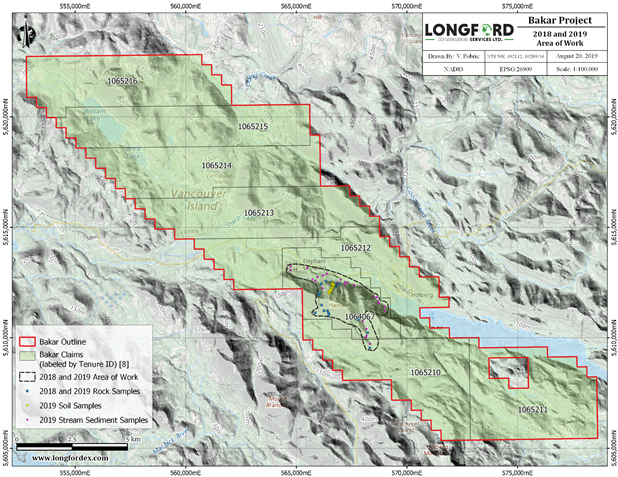
Figure 2: Channel Sampling on Bakar Property
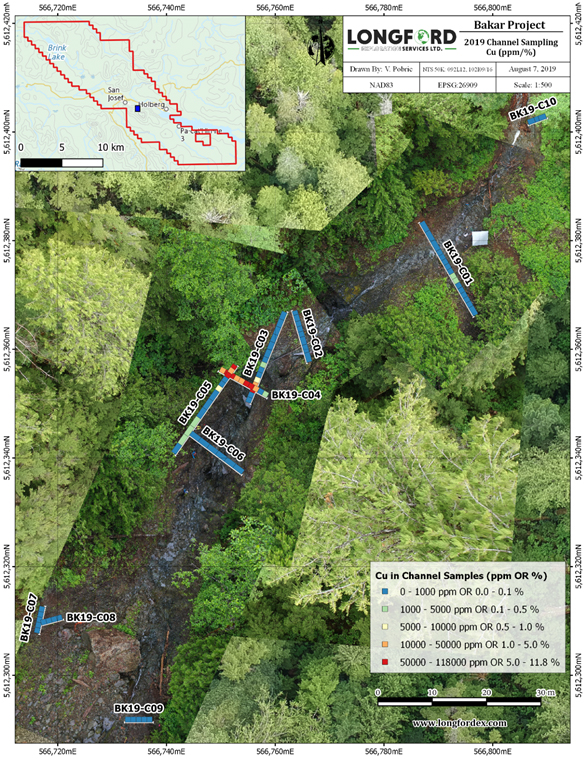
Figure 3: Soil Sampling on Bakar Property
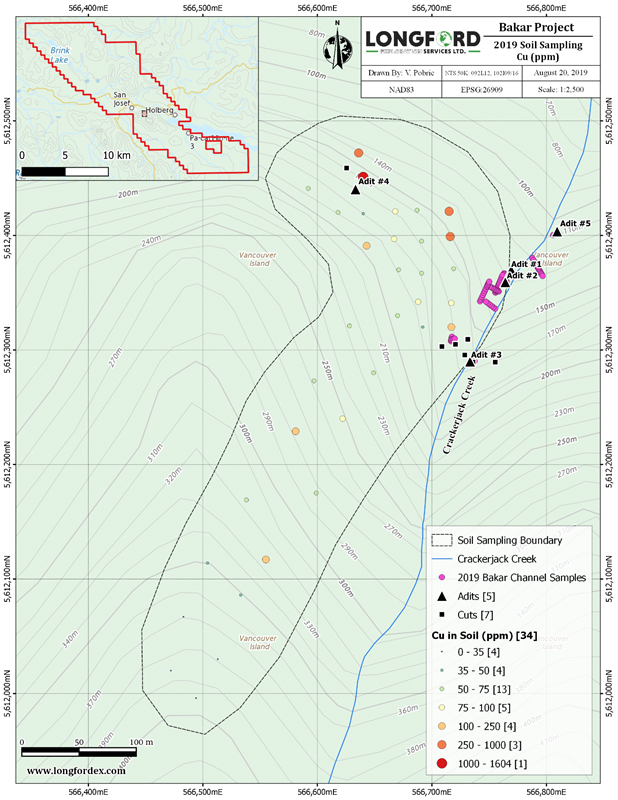
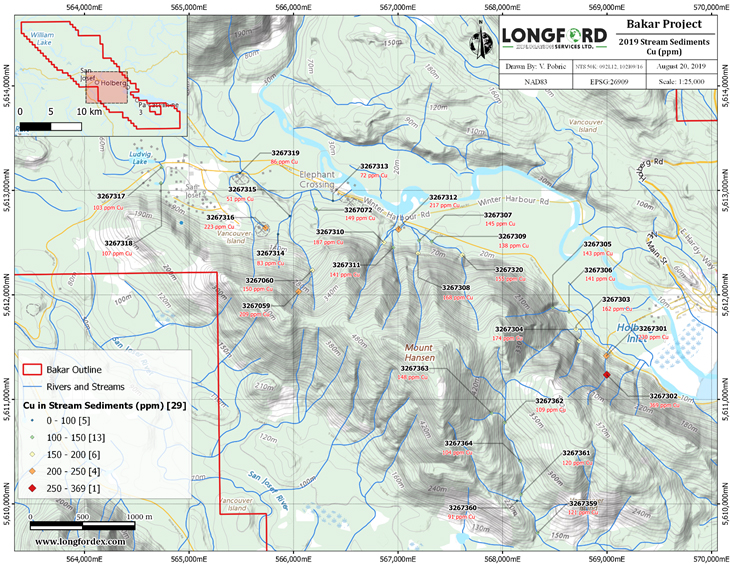
Figure 4: Stream Sediment Sampling on Bakar Property
Table 1: Channel Sample Assay Results on Bakar Property
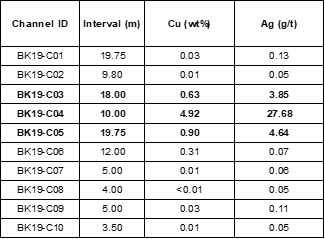
Technical Information
All scientific and technical information in this news release has been prepared by, or reviewed and approved by Garrett Ainsworth, PGeo, President and CEO of the Company. Mr. Ainsworth is a qualified person for the purposes of National Instrument 43-101 - Standards of Disclosure for Mineral Projects and has reviewed and validated that the information contained in this news release is accurate.
The rock channel samples were recovered parallel and perpendicular to mineralization across variable lengths between 3.5 to 19.75 m with a minimum channel thickness of 60 mm and minimum channel depth of 30 mm. The entire volume of each channel sample was transported from the Bakar Property by Longford Exploration Services Ltd. to Bureau Veritas Mineral Laboratories (BVML) in Vancouver, BC for preparation and analysis. Samples were analyzed for 45 elements with four acid digestion Inductivity Coupled Plasma – Mass Spectrometry (ICP-MS). Over limit sample values were re-assayed for copper values over 10.0% using copper assay by classical titration (GC820), and silver values over 200 g/t by four acid digestion Inductivity Coupled Plasma - Emission Spectroscopy (ICP-ES).
On Behalf of the Board of Directors
“Garrett Ainsworth”
President and Chief Executive Officer
604-628-5616
Neither TSX Venture Exchange nor its Regulation Services Provider (as that term is defined in policies of the TSX Venture Exchange) accepts responsibility for the adequacy or accuracy of this release.
Cautionary Statement Regarding “Forward-Looking” Information.
This news release contains "forward-looking information" within the meaning of applicable Canadian securities legislation. “Forward-looking information” includes, but is not limited to, statements with respect to the activities, events or developments that the Company expects or anticipates will or may occur in the future, including the completion and anticipated results of planned exploration activities. Generally, but not always, forward-looking information and statements can be identified by the use of words such as “plans”, “expects”, “is expected”, “budget”, “scheduled”, “estimates”, “forecasts”, “intends”, “anticipates”, or “believes” or the negative connotation thereof or variations of such words and phrases or state that certain actions, events or results “may”, “could”, “would”, “might” or “will be taken”, “occur” or “be achieved” or the negative connation thereof.
Such forward-looking information and statements are based on numerous assumptions, including among others, that the Company’s planned exploration activities will be completed in a timely manner. Although the assumptions made by the Company in providing forward-looking information or making forward-looking statements are considered reasonable by management at the time, there can be no assurance that such assumptions will prove to be accurate.
Forward-looking information and statements also involve known and unknown risks and uncertainties and other factors, which may cause actual events or results in future periods to differ materially from any projections of future events or results expressed or implied by such forward-looking information or statements, including, among others: that planned exploration activities do not achieve anticipated results or are not completed in a timely manner or at all, negative operating cash flow and dependence on third party financing, uncertainty of additional financing, no known mineral reserves or resources, reliance on key management and other personnel, potential downturns in economic conditions, changes in exploration programs based upon results, and risks generally associated with the mineral exploration industry, environmental risks, changes in laws and regulations, community relations and delays in obtaining governmental or other approvals.
Although the Company has attempted to identify important factors that could cause actual results to differ materially from those contained in the forward-looking information or implied by forward-looking information, there may be other factors that cause results not to be as anticipated, estimated or intended. There can be no assurance that forward-looking information and statements will prove to be accurate, as actual results and future events could differ materially from those anticipated, estimated or intended. Accordingly, readers should not place undue reliance on forward-looking statements or information.
The Company undertakes no obligation to update or reissue forward-looking information as a result of new information or events except as required by applicable securities laws.
